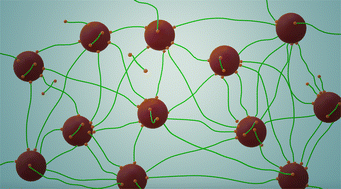Brownian dynamics simulations of telechelic polymer – latex suspensions under steady shear†
Abstract
We carry out coarse-grained Brownian dynamics simulations of shearing flow of a colloidal suspension bridged by telechelic polymers with “sticky” end groups and vary sticker strength ε over a range from 3 to 12 in units of kBT, motivated by an interest in simulating the rheology of latex paints. The most extensive results are obtained for dumbbells, but the trends are confirmed for 3-bead trumbbells and chains of up to 11 beads. The numbers of colloids and of polymers are also varied over a wide range to confirm trends established for smaller, more computationally affordable, systems. The dynamics are the result of an interplay of the shear rate and three different times scales: the time τBridge for a sticker on a bridging chain to be released from a particle surface, which scales as exp(0.77ε), the time for the polymer chain to relax, τR, which scales as the square of polymer chain length, and the time τD for a colloid to diffuse a distance comparable to its own radius, R, which scales as R3. The scalings of the bridge-to-loop and loop-to-bridge times namely τBL ∝ exp (0.75ε) and τLB ∝ exp (0.71ε), are similar to those of τBridge, for ε values above around 5 kBT, because of the relatively short chains considered here (i.e., 60 Kuhn steps). However, τR becomes more dominant for longer chains, as shown by Travitz and Larson. The zero-shear viscosity η0 is estimated from the Green–Kubo relation, and found to scale as exp (0.69ε), similar to that of τBridge. A weak influence of η0 on τD is observed, with the influence expected to become stronger when τD becomes larger, as shown previously by Wang and Larson. At shear rates in the nonlinear regime, shear-thinning is found with exponents ≈ −0.10 to −0.60, and the first normal stress difference is positive, consistent with some of the experimental data of Chatterjee et al. on model latex paint formulations. The weakness of the shear thinning, relative to that of hydrophobically modified ethoxylated urethane (HEUR) solutions without colloids, is likely due to the observed insensitivity of the loop-to-bridge and bridge-to-loop transition times to the imposed shear rate. This preliminary study provides the first mesoscale simulations of these suspensions, useful for assessing and improving both more accurate multi-scale models and eventually constitutive equations for these complex suspensions.



 Please wait while we load your content...
Please wait while we load your content...